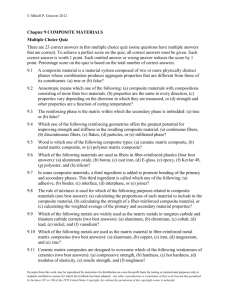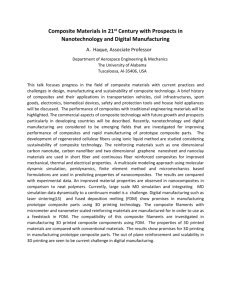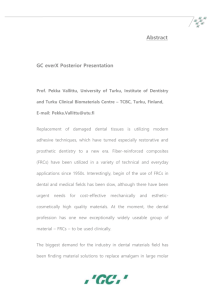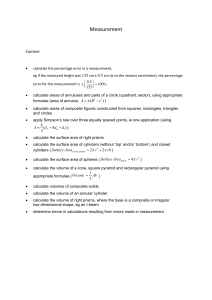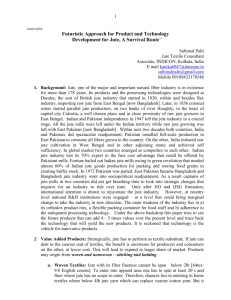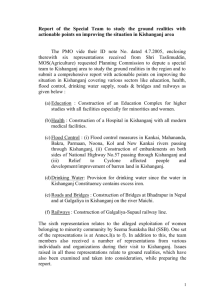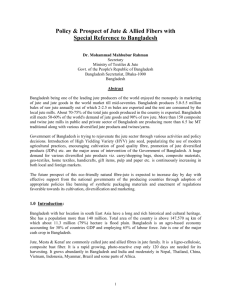I. Introduction
advertisement
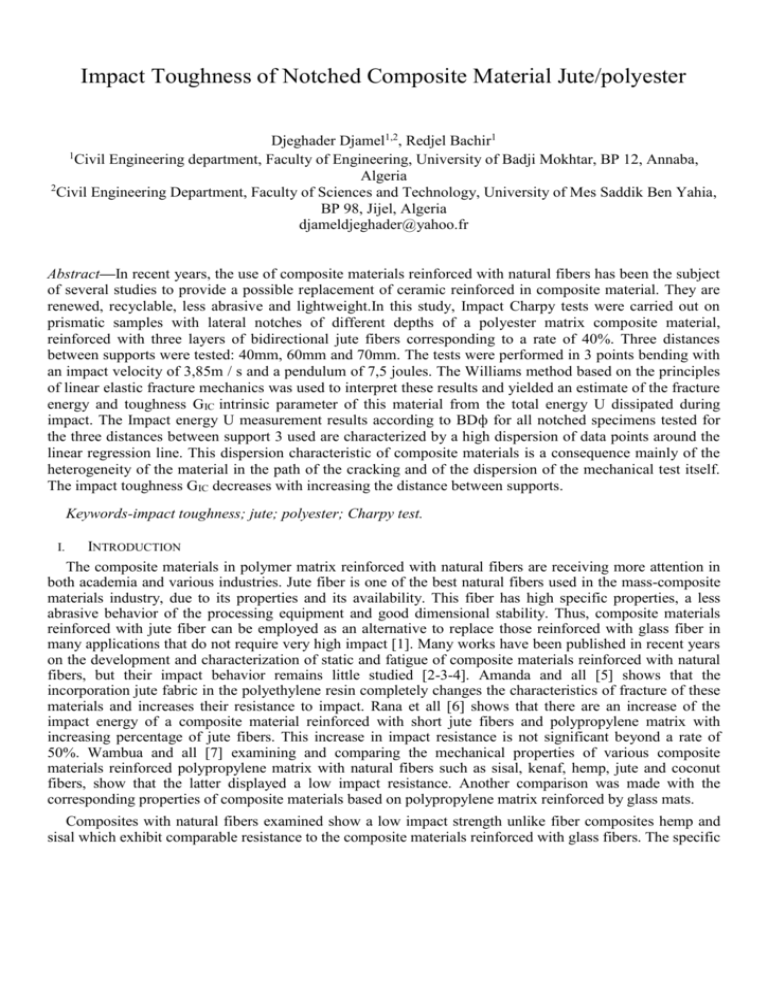
Impact Toughness of Notched Composite Material Jute/polyester Djeghader Djamel1,2, Redjel Bachir1 1 Civil Engineering department, Faculty of Engineering, University of Badji Mokhtar, BP 12, Annaba, Algeria 2 Civil Engineering Department, Faculty of Sciences and Technology, University of Mes Saddik Ben Yahia, BP 98, Jijel, Algeria djameldjeghader@yahoo.fr Abstract—In recent years, the use of composite materials reinforced with natural fibers has been the subject of several studies to provide a possible replacement of ceramic reinforced in composite material. They are renewed, recyclable, less abrasive and lightweight.In this study, Impact Charpy tests were carried out on prismatic samples with lateral notches of different depths of a polyester matrix composite material, reinforced with three layers of bidirectional jute fibers corresponding to a rate of 40%. Three distances between supports were tested: 40mm, 60mm and 70mm. The tests were performed in 3 points bending with an impact velocity of 3,85m / s and a pendulum of 7,5 joules. The Williams method based on the principles of linear elastic fracture mechanics was used to interpret these results and yielded an estimate of the fracture energy and toughness GIC intrinsic parameter of this material from the total energy U dissipated during impact. The Impact energy U measurement results according to BDф for all notched specimens tested for the three distances between support 3 used are characterized by a high dispersion of data points around the linear regression line. This dispersion characteristic of composite materials is a consequence mainly of the heterogeneity of the material in the path of the cracking and of the dispersion of the mechanical test itself. The impact toughness GIC decreases with increasing the distance between supports. Keywords-impact toughness; jute; polyester; Charpy test. INTRODUCTION The composite materials in polymer matrix reinforced with natural fibers are receiving more attention in both academia and various industries. Jute fiber is one of the best natural fibers used in the mass-composite materials industry, due to its properties and its availability. This fiber has high specific properties, a less abrasive behavior of the processing equipment and good dimensional stability. Thus, composite materials reinforced with jute fiber can be employed as an alternative to replace those reinforced with glass fiber in many applications that do not require very high impact [1]. Many works have been published in recent years on the development and characterization of static and fatigue of composite materials reinforced with natural fibers, but their impact behavior remains little studied [2-3-4]. Amanda and all [5] shows that the incorporation jute fabric in the polyethylene resin completely changes the characteristics of fracture of these materials and increases their resistance to impact. Rana et all [6] shows that there are an increase of the impact energy of a composite material reinforced with short jute fibers and polypropylene matrix with increasing percentage of jute fibers. This increase in impact resistance is not significant beyond a rate of 50%. Wambua and all [7] examining and comparing the mechanical properties of various composite materials reinforced polypropylene matrix with natural fibers such as sisal, kenaf, hemp, jute and coconut fibers, show that the latter displayed a low impact resistance. Another comparison was made with the corresponding properties of composite materials based on polypropylene matrix reinforced by glass mats. I. Composites with natural fibers examined show a low impact strength unlike fiber composites hemp and sisal which exhibit comparable resistance to the composite materials reinforced with glass fibers. The specific properties of the natural fibers composite materials are sometimes better than those of composites, Achouri and all [8] using the concepts of fracture mechanics to characterize in impact test of composite materials perlon -polyester for orthopedic use and glass-carbon-polyester show that the impact test is very depressive in its results but remains a fast evaluation of toughness parameters of composite materials for their classification. Thus, carbon-composite perlon- polyester has better resistance to cracking in the glassdynamic perlon-polyester composite. The subject of this work is to interpret the results of the impact tests on notched specimens of a bidirectional composite material using the Williams method based on the principles of linear elastic fracture mechanics. METHODES AND TECHNICAL The material used in this study was a composite polyester matrix is recessed by three layers of bidirectional jute fiber. Specimens used in the impact Charpy test are rectangular, 10mm wide and 4mm thick on average, type lateral notch SEN (single edge notch). These test pieces were cut to plates of 300x210 mm2 and notched in the middle, at different depths as showed in Figure 1. A pre notching is performed first using a special saw then tapping is continued with a rigid blade to have an acute form of the crack tip. The lengths of notches are included in the ratio 0.2 < a/D <0.6, a and D are the length of notch and the width of the specimen (Fig 1). II. Fig 1. Specimen used impact Charpy test Three distances between support used in our érude (Table1) 40mm, 60mm, 70mm TABLE 1 SPECIMEN DIMENSIONS JUTE/POLYESTER Jute/polyester 55 ±0.2 10±0.2 4±0.2 Distance between support L (mm) ≈ 40 70 ±0.2 10±0.2 4±0.2 ≈ 60 80 ±0.2 10±0.2 4±0.2 ≈ 70 Length l Width D Thickness B (mm) (mm) (mm) The tests were carried out using a Charpy impact machine with pendulum type Zwick 5113. The flip angle of the unit is 160° and the impact velocity is 3.85 m / s. The pendulum used in the case of this materials is 7.5 joules (Fig 2). Williams method based on the principles of linear elastic fracture mechanics was used to interpret the results of impact tests on notched specimens [9-10-11]. This method provides an estimate of energy or toughness GIC of the total dissipated energy during the impact U according to the equation: U = GIC. B.D.ф (1) B and D are respectively the thickness and the width of the specimen and ф is a calibration factor which depends on the specimen geometry and which was tabulated by Williams for different lengths of notch and for various ratios L / D. And recording the energy lost by the pendulum at the time of impact for each notch covered a diagram U = f (BDф) gives a straight line whose slope measurement GIC. Fig. 2. Charpy impact machine Zwick / Roell RESULTS AND DISCUSSION The graphical representation of the measurement points of the energy lost by the total rupture U hammer surface function cracks ruptured to three distances between supports used are shown in Figs 3, 4 and 5 III. 0,3 GIC = 5,04 KJ/m2 Cr = 0,64 Imacct energy U (J) 0,25 0,2 0,15 0,1 0,05 0 0 10 BDΦ (mm2) 20 30 Fig.3. Total fracture energy based on damage surfaces BDф: L = 40mm The dispersion of experimental points around linear regression lines is important in all cases tested as indicated by the correlation coefficients calculated which are much lower than 1. This dispersion also characteristic of composite materials is the result of heterogeneity especially material on the way of cracking of the manufacturing method of the notches and the dispersion of the mechanical test itself. Fig.4. Total fracture energy based on damage surfaces BDф: L = 60mm The results show that the increase in total energy to break with an increase in damage surfaces is reflected by the fact that the breaking is a phenomenon energy consumer, therefore increasing broken surfaces requires more fracture energy important. Fig. 5. Total fracture energy based on damage surfaces BDф: L = 70mm The linear regression for all distances between supports 40mm, 60mm and 70mm is provided with correlation coefficients well below 1, indicating a high dispersion of data points around the linear regression line. This dispersion is a characteristic of heterogeneous materials and is the result primarily of the heterogeneity of the material on the way of cracking of the manufacturing method of the notches so that the dispersion of the mechanical test itself. The presence of defects during manufacture of the test pieces is also a parameter favoring the measurement variability. Indeed, the distribution of jute fiber content in the polyester matrix and their orientation is not uniform within the volume of the material, which causes the often tortuous break paths that do not necessarily follow the direction and the plan the initial cut and that are different from one specimen to another. The measurement results of the dynamic toughness as a function of the distance between support 3 point bending are shown in the histogram in Figure 6 for all specimens tested. These results show that the effect of the distance between support for jute fiber material is large compared with that on other composite materials such as polyester glass for example. Indeed the impact toughness GIC decreases with increasing the distance between supports. CONCLUSION The specimens tested is characterized by a brittle fracture mode by the presence of defects due to the manufacturing method of the material A dispersion of the measurement results of the fracture toughness by using the Williams method to interpret the impact Charpy test. This is mainly due to the heterogeneity of the material. The dynamic impact toughness jute-polyester composite materials decreases with increasing distance between supports 3point bending. IV. REFERENCES [1] C. Santulli, C., “Biomimetic interest and possibilities for replacement of glass fibres with plant fibres in composite materials: the case of impact damage” Proceedings of the International School on Advanced Material Science and Technology, 26th- 29th August, – Jesi – Ancona –Italy – 2003 [2] S. Sangthong, T. Pongprayoon & N. Yanumet “ Mechanical property improvement of undaturated polyester composite reinforced wuth admicellar-treated sisal fibers” J. of Composites: Part A, 40, pp. 687-694, 2009. [3] F.A. Silva, M. Barzin & R.D.T. Filhoc “Fatigue behavior of sisal fiber reinforced cement composites”, J. of Materials Science and Engineering A, 527, pp. 5507-5513. 2010. [4] A. Athijayamania, M. Thiruchitrambalamb, U. Natarajana & B. Pazhanivel ”Effect of moisture absorption on the mechanical properties of randomly oriented natural fibers/polyester hybrid composite” J. of Materials science and Engineerin A, 517, pp. 344-353, 2009. [5] C. Amanda & L.A.H. Torrones « Impact rupture characteristics of polyethylene composites reinforced with jute fabric » Acta Microscopica, 16, N°1-2, 2007. [6] A.K. Rana, A. Mandal, L.B.C. Mitra, R. Jacobson & R. Rowell «Short jute fiber-reinforced polypropylene composites: effect of compatibilizer » Journal of Applied Polymer Science, 69, pp. 329338, (1998). [7] P. Wambua, J. Ivens & I. Verpoest « Natural fibres: can they replace glass in fibre reinforced plastics? », Composite Science and Technology, 63, Issue 9, pp. 1259-1264, 2003. [8] S. Achouri & B. Redjel « Utilisation du mouton pendule pour la mesure du taux de restitution d’énergie critique en choc de matériaux composites verre-perlon-polyester et carbone-perlon-polyester » International Conference on Mechanical Engineering, CIGM2011, 20-22 Novembre, Skikda, Algérie, 2011. [9]. C.E. Turner, “Fracture Toughness and Specific Fracture Energy: A Re-analysis of Results”, Materials Science and Engineering, 11, 275-282, 1973. [10]. J.G. Williams, “Fracture mechanics of polymers” Polymer Engineering and Science, 17, No.3, pp. 144-149, 1977. [11]. B. Redjel, « Cours Matériaux Composites », P-G, Département Génie Civil, Université de Annaba, 2007.

